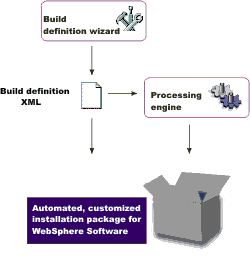Installation Factory overview
The IBM WebSphere Installation Factory is an Eclipse-based tool which creates installation packages for installing WAS in a reliable and repeatable way, tailored to the specific needs.
WAS ND v7.0 can produce two kinds of packages, a customized installation package (CIP) and an integrated installation package (IIP). A CIP is used to install a WebSphere Application Server product in addition to maintenance, profile customization, and user-defined scripting. An IIP is a larger package which can install an entire WebSphere software stack, such as an application server, a feature pack, and other user files. An IIP can even contain several CIPs.
See to begin creating an installation package.
 New feature: IBM WebSphere Installation Factory V
7.0 is backwards compatible with V6.1 and can create both V
6.1 and V7.0 installation packages. Read the topic for more information
New feature: IBM WebSphere Installation Factory V
7.0 is backwards compatible with V6.1 and can create both V
6.1 and V7.0 installation packages. Read the topic for more information
You must install IBM WebSphere Installation Factory on a distributed platform to create installation packages for IBM i. The Installation Factory does not run on an IBM i platform.
Customized installation packages
The Installation Factory combines the installation image for a version or release of a WebSphere software product with applicable maintenance packages, a configuration archive, one or more enterprise archive files, customization scripts, and other user files to create a customized installation package. We can even create a CIP containing a WebSphere feature pack and any associated feature pack fixes. We can significantly reduce the time and complexity of a standard installation process by creating and installing a CIP. Installing and configuring a WebSphere application server product is usually a multiple step process:
- Install the shipped version of WAS ND.
- Install the current fix pack.
- Install a Java™ SDK fix pack.
- Install one or more interim fixes as needed.
- Create and configure appservers and other artifacts.
- Deploy applications.
A feature pack CIP cannot also contain the application server. You must first install the appserver or an application server CIP before installing a CIP containing a feature pack. An IIP is an excellent way to install multiple products or CIPs.
The Installation Factory simplifies the process by creating a single installation image, the customized installation package.
 After creating the CIP, installing and configuring a WebSphere software product is a one-step
process: install the CIP.
After creating the CIP, installing and configuring a WebSphere software product is a one-step
process: install the CIP.
Integrated installation packages
Customers who need to install multiple installation packages in an automated and highly repeatable manner can create an IIP which aggregates those packages into a single installable package. As an example, we can have multiple servers on which we need to deploy WebSphere Application Server and some number of feature packs. Instead of having to install each of these products as an independent step on each server, you can create an IIP that will install all of them at once.
You specify which installation packages to include in the IIP, the order in which they should be installed, and various other details about the desired behavior of the IIP and each of its contained installation packages.
Each product you include in the IIP can be customized separately for greater flexibility. For example, you could run the WAS product install interactively and then run one or more feature pack installs silently to obtain a seamless install of the entire set of packages. There is also flexibility as to which contained installation packages actually get installed on any given invocation of the IIP; in other words you can choose not to install certain packages in the IIP.
One example of an IIP installation scenario...
- Install a CIP containing a WebSphere Application Server product
- Install a feature pack (or, a CIP created with a feature pack and feature pack fixes)
- Install additional user files and directories
- Install another instance of the appserver CIP in another directory on the machine
- We can create a build definition file and the entire IIP package on a local machine. The IIP might include, for example, WebSphere Application Server, feature packs, and maintenance. We can then ship the package for installation on a remote machine.
- We can create a build definition file on a local machine and ship it to a remote machine that already has the package. For example, the package might include WAS, feature packs, and maintenance. We can then run IBM WebSphere Installation Factory on the remote machine and it can use the shipped build definition file to complete the installation. After the IIP is created, we can then install the IIP on the remote machine.
See on remote IIP installation, see the topic.
Last updated Nov 11, 2010 1:01:09 PM CST
![[iSeries]](../../iseries.gif)